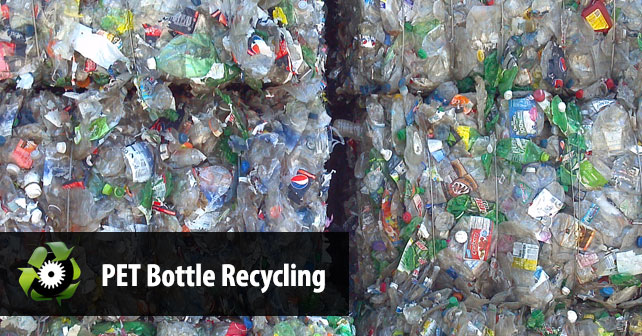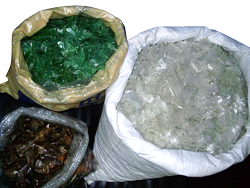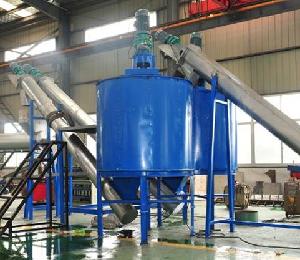
For most people, PET bottle recycling means placing your plastic bottles such as the common water bottle, soda bottle, oil bottles, and other similar products into the blue recycling bin. For some, it means bringing the bottles to a recycling center near you. While this simple gesture of “PET bottle recycling” is accurate to some extent, many more steps are involved before PET bottles can truly be recycled, processed into a new product such as polyester fiber, PET sheets/boards, or back into a PET bottle.
Collecting PET Bottles
The first step in PET recycling is the collection of bottles. As mentioned above, a large portion of collection is done via “curb-side” recycling (where trucks come to pick up the blue recycle bin) and via recycling center drop-offs. For curb-side recycling, often referred to as “single stream” recycling, all types of recyclables are placed into a single bin and trucked to a MRF (materials recovery facility) for sorting. Recyclable materials may include glass, aluminum cans, plastic bottles, and paper/cardboard. This mixed stream of recyclables are partially sorted manually and partially via recycling machinery such as a trommel, eddy current separator, and more.
Once collected and sorted at the MRF, the plastic bottles are baled into large compacted bundles (pictured above) and sent to a PET bottle washing plant either locally or abroad for processing into “hot-washed” PET flakes. Glass, metals, paper/cardboard are all packaged and sent off to their respective recycling facilities for further processing.
PET Bottle Washing/Recycling Plant
In this section, we’ll focus on the process of cleaning PET bottles and processing them into recycled PET plastic, or RPET for short.
 When the plastic bottles arrive at a PET recycling / washing plant, they are usually in large bales that have already been separated by color. The goal of a PET bottle washing plant is to recover these dirty plastic bottles and thoroughly cleaning them so they can be reused. At the same time, various contaminants must also be separated such as the plastic labels wrapped around each bottle and the bottle caps which are not made from PET plastic.
When the plastic bottles arrive at a PET recycling / washing plant, they are usually in large bales that have already been separated by color. The goal of a PET bottle washing plant is to recover these dirty plastic bottles and thoroughly cleaning them so they can be reused. At the same time, various contaminants must also be separated such as the plastic labels wrapped around each bottle and the bottle caps which are not made from PET plastic.
To clean the PET bottles, a series of recycling machinery must be used. This series of machinery, either fully or partially automated, is often times referred to as a PET bottle washing line or recycling line. There are three phases that the bottles go through including sorting, washing, and drying.
For a standard, fully automated PET washing line, the first piece of equipment is a “debaling machine” that takes large, compacted bales of PET bottles and breaks them loose so the bottles flow freely onto a belt conveyor which leads to a large trommel separation machine.
The trommel, a large rotating tunnel with holes smaller than the standard PET bottle, is a robust piece of machinery for removing small contaminants from the material stream. As most plastic bottles come from MRFs, mentioned above, it’s likely for the bales to contain various small contaminants such as broken glass, metals, rocks, paper/cardboard, etc that are leftover from the sorting of “single stream recycling” materials. These small contaminants fall through the holes on the trommel while PET bottles move forward in the washing line in a steady flow.
An accurate way to removing contaminants from the material stream is via manual sorting. For instance, a 1 gallon milk bottle (these are made from HDPE) would have made it pass the trommel process, however, this is considered a contaminant since it’s not made of PET plastic. The material stream now enters long rows of belt conveyors where attendants standing on both sides of the conveyor pluck out contaminants manually before the bottles are cut down into small pieces.
A granulator is used to cut PET bottles into small pieces of plastic shred often referred to as “PET flakes” that are 12-18mm in size. As wet granulators are often used in this process where a stream of water is sprayed onto the bottles as it is being cut, a wet granulator acts as the first stage in the washing process.
The PET flakes at this time still require a lot of work before it can be recycled into a new product. To continue the sorting process, the flakes are subjected to an air classifier where lighter materials are removed from heavier ones. This is accomplished by blowing the material stream with a column of pressurized air. In PET recycling, the use of an air classifier effectively blows the plastic film labels away from the heavier PET plastic.
Now that the bottle labels have been removed, it’s time to remove the bottle caps which are made from PP/PE plastic (polypropylene and polyethylene). This is actually a simple process where the material stream is subjected to a large tank of water, in a PET washing line, this tank is often called a float/sink separation tank. PET flakes have a density greater than water and will sink to the bottom which PP/PE plastic will float. The separation tank has screw conveyors at the bottom of the tank where PET flakes are transmitted to the next piece of machinery.
 At this time, this relatively pure stream of PET flakes will enter its first, official washing machinery, the hot boiler/steamer washer which uses hot water with the addition of a caustic or similar solution to remove glues (for glueing the labels), grease, oils, and left over liquids/foods stuck to the bottles. As these contaminants are broken down in the hot washer, a secondary cold friction washer is used to further scrub the PET flakes. Via these two pieces of washing equipment, the PET flakes are now perfectly clean and is ready for drying.
At this time, this relatively pure stream of PET flakes will enter its first, official washing machinery, the hot boiler/steamer washer which uses hot water with the addition of a caustic or similar solution to remove glues (for glueing the labels), grease, oils, and left over liquids/foods stuck to the bottles. As these contaminants are broken down in the hot washer, a secondary cold friction washer is used to further scrub the PET flakes. Via these two pieces of washing equipment, the PET flakes are now perfectly clean and is ready for drying.
To actually reuse the PET flakes, it must be dry since melting PET flakes with water inside will leave air bubbles in the final product (not desirable). Hence, an elaborate drying system must be implemented to efficiently get rid of all the water. The first step is the use of a de-watering machine which uses centrifugal force to spin away a large portion of the water. Further drying is done by a dehydration process where thermal heaters are used to bake the PET flakes down to moisture levels below 1 percent.
At the end of a PET bottle recycling line are clean, contaminant-free PET flakes ready for use in the manufacturing of various recycled products.
RPET Products
Now that we have clean PET flakes, what can they be used for? The first, and probably largest use of PET flakes is in the production of polyester staple fibres which in turn can be woven into clothing and or various applications such as carpets, handbags, etc.
RPET can also be used in manufacturing PET sheets / boards, PET strapping, thermoforming applications such as laundry scoops, engineering application such as reinforced components for automobiles, as well as back into PET bottles for packaging applications. In this scenario, the PET flakes must first undergo an extrusion process often called “pelletizing” where PET flakes are melted and shaped into pellets. Once PET pellets are made, it can be manufactured into a variety of products via injection moulding or other processes.


